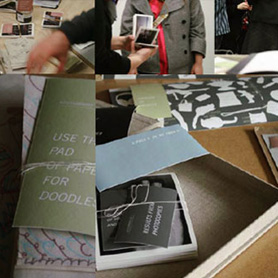Jaime Barrett
Designer and Researcher at Pinch
Primary design concentration:
Graphic Design (printed matter, typography, illustration, branding)
Most preferred tool for designing:
Pen and paper; preferably a Staedtler permanent Lumocolor pen with tracing paper.
1. How and why did you choose to become a designer?
I started my undergraduate pursuit of the fine arts in oil painting. When I caught myself wanting to paint words on top of my paintings I thought that perhaps I should look into graphic design. Marrying words and images was always an interest of mine. Needless to say, I loved my first design class. I moved to Paris for a year that summer and studied at an art school where they had a few design classes—which tipped the scales enough for me to want to pursue design wholeheartedly. I came back the next year, switched my major from oil painting to design, and never looked back.
2. Challenges you encounter as a designer and how do you deal with them?
The greatest thing about design that I learned as a student is that it can offer a range of personal creative outlets: as a student I definitely explored the bounds of my personal interests as an artist / designer. Today, as I work with clients and other professionals, the hardest part is still being able to retain a bit of this experimentation and personal creativity (at the very least in the process) while still making something that will keep the client happy. As much as I love the challenge of trying to win a client over; it’s always a touchy, diplomatic effort to involve them, to get their feedback and to still create something that is appropriate and beautiful.
I don’t think I’ve really ever navigated this situation perfectly and I think this is the ultimate pursuit of mine: to continue trying to improve my craft and approach while acting professionally. I want to be just as happy with my work, with how I’ve conducted myself and with maintaining a good rapport among my clients.
3. Your definition of an “elegant solution,” that is, good design?
Good design, in my opinion, is a mixture of intuition, sensitivity and thoughtfulness. Something that is well designed just looks right and every element that makes up the composition feels that it’s in the right place and has reached the right balance—there’s no other place where each element should be—and the relationship of color, balance, size, position, hierarchy all build nicely into this.
There is also a bit of magic in the design process that is hard to explain (which is maybe just another word for intuition). But I do find that sensitivity is a huge part of being a good designer—and making “good design.” I do feel that part of this is not necessarily learned behavior, but just exists in certain people.
4. From skills to values, what makes a designer successful?
A successful designer can take criticism and feedback. She knows how to listen, employ sensibility when working with others, she builds a network and never leaves opportunity for bad blood in her industry. Tactfulness and patience should be cultivated whenever possible. However, nerves of steel and a penchant for standing up (albeit tactfully) for what one believes is very important—she’s not a pushover. Most importantly, she’s articulate and can explain her work without wavering or second-guessing herself.
5. How do you stay motivated and grow personally and professionally as a designer?
Oh man, this is a touchy subject. I’m always trying to do too much—there’s not enough hours in the day to do all that I would like. I always love to poke around the web and see what others are doing, making, saying; which is always good motivation. I feel this innate burning sense of inadequacy—that I haven’t hit my stride or reached my full potential yet and that keeps me going.
My mind incessantly churns things over and over: what I could’ve done differently, what I could be doing now (design-wise). I think it’s all that sense of wanting to hit a stride where I’ve finally come into my own, as they say. I’m still going through design puberty.
6. For those aspiring to become a designer, whatever the discipline,what is your advice?
Do it! But do it for the love of the craft and stick to it. Stay honest, work hard and love what you do. Always try to be the best. Personal endeavor has always paid better than the money.
7. What is your quest in design?
This relates to what I said earlier about hitting my stride. I would hope that I simply and only create beauty. I would love to be able to have perfected my craft where clients would approach me to provide them with what I love to do (isn’t this everyone’s dream?). I also hope my curiosity is never fully satiated and that would require me to travel, to continually search out new skills and to improve my design sensibilities. A future goal is to become a visiting professor at a local undergraduate school, where I’d probably end up learning more from the students than they would from me.
Previous: Lottie Crumbleholme | Next: Justin Kemerling

Support this solo initiative
What began as a collection of links has evolved into a comprehensive archive committed to creative culture—offering so far 395 interviews with under-the-radar Artists, Designers & Makers, in addition to 202 write-ups across events, books, movies, more. Free to explore. Free from ads. If you gain a level of motivation, knowledge, even delight, from Design Feast, please support on Patreon. Thanks for your consideration!
Wishing you continual success,
Nate Burgos, Content Creator & Publisher
Comments
There are no comments yet.
Leave Your Comment